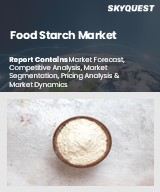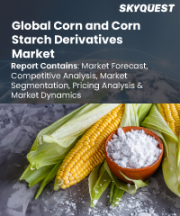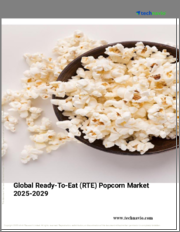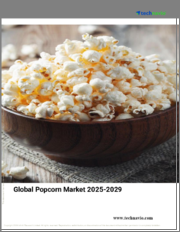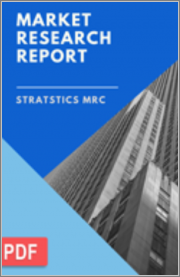
|
시장보고서
상품코드
1324232
세계의 유기농 옥수수 시장 예측(-2030년) : 제품 유형별, 유형별, 형태별, 용도별, 최종 사용자별, 지역별 분석Organic Corn Market Forecasts to 2030 - Global Analysis By Product Type (Organic Yellow Corn, Organic White Corn and Other Product Types), Type (Fresh, Dry and Frozen), Form (Granules, Flour and Oil), Application, End User and By Geography |
||||||
세계의 유기농 옥수수(Organic Corn) 시장은 2023년에 19억 2,000만 달러에서, 예측 기간 동안 CAGR 17.2%로 추이하여 2030년에는 58억 4,000만 달러에 이를 전망입니다.
유기농법은 비교적 최근에 개발된 작물 재배 기술입니다. 이 기술은 작물 순환, 동반 심기, 골분과 같은 방법을 사용하여 작물 내에 필수 영양소를 주입합니다. 작물은 그 특성상 영양 집약적이기 때문에 토양의 건강을 위해 지속적으로 영양분을 보충하면서 재배해야 합니다. 유기농은 이를 위한 자연스럽고 지속 가능한 방법입니다. 유기농 옥수수는 환경과 개인 건강을 위해 화학물질 사용을 줄여야 한다는 요구가 커지면서 사회적으로 각광받고 있는 추세의 산물입니다.
미국 농무부(USDA)의 조사에 따르면, 2016년 미국 유기농 인증 농장 수는 11% 증가한 14,217개, 인증 면적은 15% 증가한 5백만 에이커에 달했습니다.
소비자 수요 증가
유기농 옥수수 시장은 대부분 소비자 수요 증가에 의해 주도되고 있으며, 이는 농업 환경도 재편하고 있습니다. 환경에 대한 관심과 건강에 대한 의식이 높아지면서 유기농 제품, 특히 유기농 옥수수에 대한 선호도가 높아지고 있습니다. 합성 살충제 및 유전자 변형 생물체(GMO) 사용과 같은 기존 농법과 관련된 건강 위험 가능성에 대한 지식이 증가함에 따라 소비자들은 보다 안전하고 자연적인 옵션을 찾고 있습니다.
기후 변화 및 기상 이변
유기농 옥수수 시장은 기후 변화와 기상 현상으로 인해 심각한 제약을 받고 있으며, 이는 전반적인 시장 안정성에도 위협이 되고 있습니다. 지구 온난화로 인해 기후가 변화함에 따라 가뭄, 홍수, 폭염, 불규칙한 강우 패턴 등 극심한 기상 현상이 빈도와 강도가 증가하고 있습니다. 이러한 불리한 기후 조건은 유기농 옥수수 수확에 심각한 영향을 미쳐 수확량 감소와 품질 저하를 초래할 수 있습니다.
프리미엄 가격
프리미엄 가격은 유기농 옥수수 시장에서 중요한 기회를 제공하며, 농부와 기업이 유기농 옥수수 재배에 투자할 수 있도록 더 높은 수익률과 재정적인센티브를 제공합니다. 일반 옥수수와 비교하여 유기농 옥수수는 일반적으로 뚜렷한 품질과 유기농 농법과 관련된 추가 비용으로 인해 프리미엄 가격이 책정됩니다. 소비자들은 유기농 옥수수를 포함한 유기농 제품에 대한 건강 및 환경적 이점 때문에 점점 더 높은 가격을 기꺼이 지불하고 있습니다.
사기 및 허위 라벨링
사기와 허위 라벨링은 유기농 옥수수 시장에 심각한 위협이 되고 있으며, 유기농 제품의 진품에 대한 소비자의 신뢰와 믿음을 약화시킵니다. 유기농 식품에 대한 수요가 증가하고 프리미엄 가격이 형성됨에 따라 부도덕한 행위자들이 기만적인 행위를 통해 이러한 상황을 이용하려고 시도할 수 있습니다. 여기에는 유기농이 아닌 옥수수를 유기농으로 잘못 표시하거나, 일반 옥수수와 유기농 옥수수를 혼합하거나, 오해의 소지가 있는 포장 및 라벨을 사용하여 유기농 품질에 대한 잘못된 인식을 심어주는 행위가 포함됩니다.
COVID-19의 영향 :
COVID-19 팬데믹은 유기농 옥수수 시장에 상당한 영향을 미치며 도전과 기회를 동시에 가져왔습니다. 팬데믹 초기 단계에서는 공급망과 물류에 차질이 생기면서 유기농 옥수수 농가와 수출업체가 어려움을 겪었습니다. 이동 제한과 노동력 부족은 농업 활동을 방해하여 재배, 수확, 운송에 영향을 미쳤습니다. 또한 시장의 불확실성은 수요의 변동으로 이어져 가격과 거래량에 영향을 미쳤습니다.
예측 기간 동안 동물사료 부문이 최대가 될 전망
동물 사료 부문은 영양가 있고 지속 가능한 사료 옵션으로 시장에서 가장 큰 점유율을 차지하고 있으며, 유기농 옥수수는 가축, 가금류 및 기타 동물에게 필수 탄수화물, 단백질 및 에너지를 제공하므로 유기농 인증 요건을 충족하고 증가하는 유기농 동물 제품에 대한 수요를 충족하려는 농부에게 이상적인 선택입니다. 하지만 유기농 옥수수의 매력은 합성 살충제, GMO, 화학 비료를 사용하지 않고 재배하여 동물에게 더 자연스럽고 건강한 사료를 공급할 수 있다는 데 있습니다. 이는 유기농 및 환경을 생각하는 농업 관행에 대한 소비자의 선호도와 일치합니다.
유기농 옐로우 콘 부문은 예측 기간 중 가장 높은 CAGR이 예상
예측 기간 동안 유기농 옐로우 콘 부문은 가장 큰 CAGR을 가질 것으로 예상됩니다. 유기농 옐로우 콘는 건강에 대한 장점과 환경 친화적인 농법으로 인해 많은 문화권에서 주식으로 인기를 얻고 있습니다. 합성 살충제, 유전자 변형 생물체, 화학 비료가 없는 유기농 옐로우 콘는 건강에 좋은 천연 식품을 찾는 소비자들에게 매력적입니다. 황색 유기농 옥수수는 다양한 산업 분야에서 폭넓게 사용되기 때문에 유기농 옥수수 시장에서 수요가 점점 증가하고 있습니다.
최대 점유율을 가진 지역
북미 지역은 유기농 및 지속 가능한 식품에 대한이 지역의 증가하는 수요를 반영하여 예측 기간 동안 유기농 옥수수 시장에서 가장 높은 점유율을 보일 것으로 예상됩니다. 미국, 캐나다, 멕시코의 소비자들은 점점 더 건강하고 환경 친화적인 식품을 찾고 있으며, 이는 유기농 옥수수의 인기를 견인하고 있습니다. 유기농 옥수수는 합성 살충제, GMO, 화학 비료를 사용하지 않고 재배되기 때문에 건강에 관심이 많은 사람들이 선호합니다. 또한, 이 지역의 탄탄한 유기농 농업 인프라와 우호적인 정부 규제 및 소비자 인식이 유기농 옥수수 재배 확대에 기여하고 있습니다.
CAGR이 가장 높은 지역 :
아시아 태평양 지역은 예측 기간 동안 가장 높은 성장률을 보일 것으로 예상됩니다. 소비자가 건강에 대한 의식이 높아지고 환경에 대한 인식이 높아짐에 따라이 지역에서 유기농 및 천연 식품에 대한 수요가 급증했습니다. 합성 살충제, 유전자 변형 생물체(GMO) 및 화학 비료가 없는 유기농 옥수수는 더 건강하고 안전한 식품 옵션을 찾는 소비자들에게 어필합니다. 또한 유기농 농법은 토양의 건강, 생물 다양성 및 지속 가능한 농업 시스템을 촉진하여 지속 가능한 관행에 대한 이 지역의 관심 증가에 부응합니다.
무료 사용자 지정 옵션 :
이 보고서를 구독하는 고객에게는 다음 무료 사용자 정의 옵션 중 하나를 제공합니다.
- 기업 개요
- 추가 시장 기업의 종합적 프로파일링(3사까지)
- 주요 기업의 SWOT 분석(3사까지)
- 지역 세분화
- 고객 관심에 따른 주요 국가 시장 추정 및 예측·CAGR(주 : 타당성 확인에 따라 다름)
- 경쟁 벤치마킹
- 제품 포트폴리오, 지리적 입지, 전략적 제휴에 기반한 주요 기업 벤치마킹
목차
제1장 주요 요약
제2장 서문
- 개요
- 이해관계자
- 조사 범위
- 조사 방법
- 데이터 마이닝
- 데이터 분석
- 데이터 검증
- 조사 접근
- 조사 소스
- 1차 조사 소스
- 2차 조사 소스
- 가정
제3장 시장 동향 분석
- 성장 촉진 요인
- 억제 요인
- 기회
- 위협
- 제품 분석
- 용도 분석
- 최종 사용자 분석
- 신흥 시장
- COVID-19의 영향
제4장 Porter's Five Forces 분석
- 공급기업의 협상력
- 구매자의 협상력
- 대체품의 위협
- 신규 참가업체의 위협
- 경쟁 기업간 경쟁 관계
제5장 세계의 유기농 옥수수 시장 : 제품 유형별
- 유기농 옐로우 콘
- 유기농 화이트 콘
- 유기농 블루 콘
- 기타 제품 유형
제6장 세계의 유기농 옥수수 시장 : 유형별
- 신선
- 건조
- 냉동
제7장 세계의 유기농 옥수수 시장 : 형태별
- 과립
- 분말
- 기름
제8장 세계의 유기농 옥수수 시장 : 용도별
- 식품
- 음료
- 동물사료
- 화장품
- 의약품
- 바이오연료
- 기타 용도
제9장 세계의 유기농 옥수수 시장 : 최종 사용자별
- 직접 판매
- 슈퍼마켓
- 하이퍼마켓
- 간접판매
- 소매점
- 편의점
- 온라인 소매
- 전문점
제10장 세계의 유기농 옥수수 시장 : 지역별
- 북미
- 미국
- 캐나다
- 멕시코
- 유럽
- 독일
- 영국
- 이탈리아
- 프랑스
- 스페인
- 기타 유럽
- 아시아 태평양
- 일본
- 중국
- 인도
- 호주
- 뉴질랜드
- 한국
- 기타 아시아 태평양
- 남미
- 아르헨티나
- 브라질
- 칠레
- 기타 남미
- 중동 및 아프리카
- 사우디아라비아
- 아랍에미리트(UAE)
- 카타르
- 남아프리카
- 기타 중동 및 아프리카
제11장 주요 발전
- 계약/파트너십/협업/합작투자(JV)
- 인수와 합병
- 신제품 발매
- 사업 확대
- 기타 주요 전략
제12장 기업 개요
- Albert Lea Seed
- Anson Mills
- Bradner Farms
- Grain Millers, Inc.
- Johnny's Selected Seeds
- La Milanaise
- Scratch and Peck Feeds
- SK Food International
- SunOpta Inc.
- Sunora Foods
According to Stratistics MRC, the Global Organic Corn Market is accounted for $1.92 billion in 2023 and is expected to reach $5.84 billion by 2030 growing at a CAGR of 17.2% during the forecast period. Organic farming is a relatively recent technique for growing crops. This technique uses methods such as crop rotation, companion planting and bone meals to instil essential nutrients within a crop. Crops by their nature are nutrient intensive and need to be grown with constant replenishment of soil health. Organic farming is a natural, sustainable way to do this. Organic corns are a product of this trend that has caught on social fascination as environmental and personal health demand reduction in the usage of chemicals.
According to the U.S. Department of Agriculture's (USDA) Survey, 2016, number of the US certified-organic farms increased by 11 % to 14,217 and number of certified-acres increased by 15 % to 5 Mn.
Market Dynamics:
Driver:
Increasing consumer demand
The organic corn market is mostly driven by rising consumer demand, which is also reshaping the agricultural landscape. There is a rising preference for organic goods, especially organic maize, as customers become more environmentally concerned and health-conscious. Consumers are looking for safer and more natural options due to the growing knowledge of the possible health dangers associated with conventional farming methods, such as the use of synthetic pesticides and genetically modified organisms (GMOs).
Restraint:
Climate change and weather events
The market for organic corn is severely constrained by climate change and meteorological phenomena, which also threaten market stability in general. Extreme weather events including droughts, floods, heat waves, and erratic rainfall patterns increase in frequency and intensity as the climate changes as a result of global warming. These unfavorable climatic conditions may have a severe impact on organic corn harvests, resulting in lower yields and lower-quality products.
Opportunity:
Premium pricing
Premium pricing presents a significant opportunity in the organic corn market, offering farmers and businesses higher profit margins and financial incentives to invest in organic corn cultivation. Compared to conventional corn, organic corn typically commands a premium price due to its distinct qualities and the additional costs associated with organic farming practices. Consumers are increasingly willing to pay a higher price for organic products, including organic corn, because of the perceived health and environmental benefits.
Threat:
Fraud and mislabelling
Fraud and mislabeling pose significant threats to the organic corn market, undermining consumer trust and confidence in the authenticity of organic products. With the increasing demand for organic foods and the premium prices they command, unscrupulous actors may attempt to take advantage of the situation by engaging in deceptive practices. This includes mislabeling non-organic corn as organic, mixing conventional corn with organic corn, or using misleading packaging and labeling to create a false perception of organic quality.
COVID-19 Impact:
The COVID-19 pandemic has had significant implications for the organic corn market, causing both challenges and opportunities. In the initial phases of the pandemic, disruptions to supply chains and logistics posed obstacles for organic corn farmers and exporters. Restrictions on movement and labor shortages hindered agricultural activities, affecting planting, harvesting, and transportation. Moreover, uncertainties in the market led to fluctuations in demand, impacting prices and trade volumes.
The animal feed segment is expected to be the largest during the forecast period
The animal feed segment held the largest share in the market as a nutritious and sustainable feed option, organic corn provides essential carbohydrates, proteins, and energy for livestock, poultry, and other animals, making it an ideal choice for farmers seeking to meet organic certification requirements and cater to the growing demand for organic animal products. However, Organic corn's appeal lies in its cultivation without synthetic pesticides, GMOs, or chemical fertilizers, ensuring a more natural and healthier feed source for animals. This aligns with consumers' preferences for organic and environmentally conscious agricultural practices.
The organic yellow corn segment is expected to have the highest CAGR during the forecast period
During the projection period, the organic yellow corn segment is expected to have the greatest CAGR. Organic yellow corn has become popular as a staple meal in many cultures because of its advantages for health and its environmentally friendly farming methods. The absence of synthetic pesticides, genetically modified organisms, and chemical fertilizers make organic yellow corn appealing to consumers looking for wholesome and all-natural food options. Yellow organic maize is increasingly in demand on the organic corn market due to its wide use across numerous industries.
Region with largest share:
The North America region is estimated to witness the highest share of the global Organic Corn market during the forecast period reflecting the region's growing demand for organic and sustainable food products. Consumers in the United States, Canada, and Mexico are increasingly seeking healthier and more environmentally friendly food options, driving the popularity of organic corn. Organic corn is cultivated without synthetic pesticides, GMOs, or chemical fertilizers, making it a preferred choice among health-conscious individuals. Additionally, the region's robust organic farming infrastructure, coupled with favorable government regulations and consumer awareness, has contributed to the expansion of organic corn cultivation.
Region with highest CAGR:
The Asia Pacific region is expected to have the highest growth rate over the forecast period. As consumers become more health-conscious and environmentally aware, the demand for organic and natural food products has surged in the region. Organic corn, being free from synthetic pesticides, genetically modified organisms (GMOs), and chemical fertilizers, appeals to consumers seeking healthier and safer food options. Moreover, organic farming practices promote soil health, biodiversity, and sustainable agricultural systems, aligning with the region's growing focus on sustainable practices.
Key players in the market:
Some of the key players in Organic Corn market include: Albert Lea Seed, Anson Mills, Bradner Farms, Grain Millers, Inc., Johnny's Selected Seeds, La Milanaise, Scratch and Peck Feeds, SK Food International, SunOpta Inc. and Sunora Foods.
Key Developments:
In August 2022, La Milanaise Launched Organic Adzuki Beans Small and red, the Organic Adzuki bean are most commonly used in sweet dishes and as bean paste.
In January 2022, Anson Mills Launched Coarse White Grits With particles of corn ranging in size from 1/6 to 1/26 of an inch, Anson Mills coarse grits are produced from field ripened Carolina Gourdseed White or John Haulk Yellow dent mill corns, each prized historically for exceptional flavor and texture-and each, until recently, nearly extinct.
In December 2021, Albert Lea Seed launched its Organic Alfalfa is a tap-rooted, multi-cut, perennial forage legume. It is very productive, drought tolerant, widely adapted, and is the second most commonly planted forage legume in the world
Product Types Covered:
- Organic Yellow Corn
- Organic White Corn
- Organic Blue Corn
- Other Product Types
Types Covered:
- Fresh
- Dry
- Frozen
Forms Covered:
- Granules
- Flour
- Oil
Applications Covered:
- Food
- Beverage
- Animal Feed
- Cosmetics
- Pharmaceutical
- Biofuel
- Other Applications
End Users Covered:
- Direct Sales
- Indirect Sales
Regions Covered:
- North America
- US
- Canada
- Mexico
- Europe
- Germany
- UK
- Italy
- France
- Spain
- Rest of Europe
- Asia Pacific
- Japan
- China
- India
- Australia
- New Zealand
- South Korea
- Rest of Asia Pacific
- South America
- Argentina
- Brazil
- Chile
- Rest of South America
- Middle East & Africa
- Saudi Arabia
- UAE
- Qatar
- South Africa
- Rest of Middle East & Africa
What our report offers:
- Market share assessments for the regional and country-level segments
- Strategic recommendations for the new entrants
- Covers Market data for the years 2021, 2022, 2023, 2026, and 2030
- Market Trends (Drivers, Constraints, Opportunities, Threats, Challenges, Investment Opportunities, and recommendations)
- Strategic recommendations in key business segments based on the market estimations
- Competitive landscaping mapping the key common trends
- Company profiling with detailed strategies, financials, and recent developments
- Supply chain trends mapping the latest technological advancements
Free Customization Offerings:
All the customers of this report will be entitled to receive one of the following free customization options:
- Company Profiling
- Comprehensive profiling of additional market players (up to 3)
- SWOT Analysis of key players (up to 3)
- Regional Segmentation
- Market estimations, Forecasts and CAGR of any prominent country as per the client's interest (Note: Depends on feasibility check)
- Competitive Benchmarking
- Benchmarking of key players based on product portfolio, geographical presence, and strategic alliances
Table of Contents
1 Executive Summary
2 Preface
- 2.1 Abstract
- 2.2 Stake Holders
- 2.3 Research Scope
- 2.4 Research Methodology
- 2.4.1 Data Mining
- 2.4.2 Data Analysis
- 2.4.3 Data Validation
- 2.4.4 Research Approach
- 2.5 Research Sources
- 2.5.1 Primary Research Sources
- 2.5.2 Secondary Research Sources
- 2.5.3 Assumptions
3 Market Trend Analysis
- 3.1 Introduction
- 3.2 Drivers
- 3.3 Restraints
- 3.4 Opportunities
- 3.5 Threats
- 3.6 Product Analysis
- 3.7 Application Analysis
- 3.8 End User Analysis
- 3.9 Emerging Markets
- 3.10 Impact of Covid-19
4 Porters Five Force Analysis
- 4.1 Bargaining power of suppliers
- 4.2 Bargaining power of buyers
- 4.3 Threat of substitutes
- 4.4 Threat of new entrants
- 4.5 Competitive rivalry
5 Global Organic Corn Market, By Product Type
- 5.1 Introduction
- 5.2 Organic Yellow Corn
- 5.3 Organic White Corn
- 5.4 Organic Blue Corn
- 5.5 Other Product Types
6 Global Organic Corn Market, By Type
- 6.1 Introduction
- 6.2 Fresh
- 6.3 Dry
- 6.4 Frozen
7 Global Organic Corn Market, By Form
- 7.1 Introduction
- 7.2 Granules
- 7.3 Flour
- 7.4 Oil
8 Global Organic Corn Market, By Application
- 8.1 Introduction
- 8.2 Food
- 8.3 Beverage
- 8.4 Animal Feed
- 8.5 Cosmetics
- 8.6 Pharmaceutical
- 8.7 Biofuel
- 8.8 Other Applications
9 Global Organic Corn Market, By End User
- 9.1 Introduction
- 9.2 Direct Sales
- 9.2.1 Supermarket
- 9.2.2 Hypermarket
- 9.3 Indirect Sales
- 9.3.1 Retail Stores
- 9.3.2 Convenience Stores
- 9.3.3 Online Retail
- 9.3.4 Specialty Stores
10 Global Organic Corn Market, By Geography
- 10.1 Introduction
- 10.2 North America
- 10.2.1 US
- 10.2.2 Canada
- 10.2.3 Mexico
- 10.3 Europe
- 10.3.1 Germany
- 10.3.2 UK
- 10.3.3 Italy
- 10.3.4 France
- 10.3.5 Spain
- 10.3.6 Rest of Europe
- 10.4 Asia Pacific
- 10.4.1 Japan
- 10.4.2 China
- 10.4.3 India
- 10.4.4 Australia
- 10.4.5 New Zealand
- 10.4.6 South Korea
- 10.4.7 Rest of Asia Pacific
- 10.5 South America
- 10.5.1 Argentina
- 10.5.2 Brazil
- 10.5.3 Chile
- 10.5.4 Rest of South America
- 10.6 Middle East & Africa
- 10.6.1 Saudi Arabia
- 10.6.2 UAE
- 10.6.3 Qatar
- 10.6.4 South Africa
- 10.6.5 Rest of Middle East & Africa
11 Key Developments
- 11.1 Agreements, Partnerships, Collaborations and Joint Ventures
- 11.2 Acquisitions & Mergers
- 11.3 New Product Launch
- 11.4 Expansions
- 11.5 Other Key Strategies
12 Company Profiling
- 12.1 Albert Lea Seed
- 12.2 Anson Mills
- 12.3 Bradner Farms
- 12.4 Grain Millers, Inc.
- 12.5 Johnny's Selected Seeds
- 12.6 La Milanaise
- 12.7 Scratch and Peck Feeds
- 12.8 SK Food International
- 12.9 SunOpta Inc.
- 12.10 Sunora Foods






